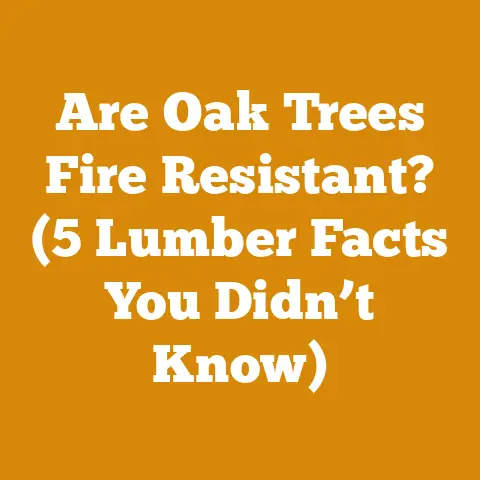Ash Tree Roots Removal (Stump & Root Kill Techniques)
Let’s talk about future-proofing your property. Removing tree stumps and roots isn’t just about aesthetics; it’s about preventing future problems like unwanted saplings, attracting pests, and even potential damage to your property’s foundation or underground utilities. I’ve spent years in the wood processing and firewood preparation business, and I’ve seen firsthand how a neglected stump can turn into a major headache. So, let’s dive into the world of ash tree root removal, covering everything from stump grinding to chemical treatments, with practical advice gleaned from my own experiences.
Understanding the Challenge: Ash Trees and Their Roots
Before we get into the how-to, let’s understand what we’re dealing with. Ash trees (genus Fraxinus) are known for their strong, extensive root systems. These roots can spread far and wide, making complete removal a challenge. Furthermore, ash trees are particularly susceptible to the Emerald Ash Borer (EAB), an invasive insect that has decimated ash populations across North America. If your ash tree was removed due to EAB infestation, it’s crucial to remove the stump and roots to prevent the spread of the borer and to eliminate a potential breeding ground.
- Ash Tree Characteristics: Strong, dense wood; susceptible to Emerald Ash Borer; extensive root system.
- Root System: Typically shallow but widespread, with a network of smaller roots branching out from the main lateral roots.
- Challenges: Hardwood roots are tough to cut; sprouting can occur from remaining root fragments.
Method 1: Manual Stump Removal – The Hard Way (But Rewarding)
This method involves physically digging out the stump and roots. It’s labor-intensive but effective, especially for smaller stumps or when you want to avoid chemicals.
Step 1: Preparation and Safety
- Tools: Shovel, pickaxe, mattock, root saw (reciprocating saw with a long blade specifically designed for cutting roots), loppers, work gloves, safety glasses, sturdy boots.
- Safety First: Always wear safety glasses to protect your eyes from flying debris. Wear gloves to protect your hands. Be mindful of your surroundings and watch out for tripping hazards.
- Clear the Area: Remove any rocks, debris, or other obstacles around the stump.
Step 2: Exposing the Roots
- Dig Around the Stump: Start digging a wide circle around the stump, about 2-3 feet away from the stump’s edge. Dig down until you expose the larger roots.
- Use a Pickaxe or Mattock: If the soil is hard-packed, use a pickaxe or mattock to loosen it.
- Loppers for Small Roots: Use loppers to cut any small roots you encounter.
Step 3: Cutting the Roots
- Root Saw is Key: A root saw is invaluable for this step. Its long, aggressive blade can cut through thick roots.
- Reciprocating Saw Alternative: If you don’t have a root saw, a reciprocating saw with a long, aggressive wood-cutting blade can work, but be prepared to change blades frequently.
- Cut Strategically: Focus on cutting the larger lateral roots first. This will make the stump easier to move.
- Safety Note: Be extremely careful when using a saw near roots. The blade can bind or kick back if it hits a rock or other obstruction.
Step 4: Wiggling and Lifting
- Wiggle the Stump: Once you’ve cut most of the larger roots, try wiggling the stump back and forth. This will help loosen any remaining roots.
- Leverage if Needed: If the stump is heavy, use a lever (a long piece of wood or a pry bar) to help lift it. Place the lever under the stump and use a fulcrum (a rock or block of wood) to gain leverage.
- Cut Remaining Roots: As you lift the stump, you’ll likely encounter more roots. Cut these as you go.
Step 5: Removing the Stump
- Lift and Remove: Once all the roots are cut, you should be able to lift the stump out of the ground.
- Heavy Stump Considerations: For larger stumps, you may need to use a come-along winch or even rent a small excavator.
- Dispose of the Stump: Dispose of the stump and roots properly. You can haul them to a landfill, burn them (where permitted), or chip them for mulch.
Step 6: Backfilling and Cleanup
- Fill the Hole: Fill the hole with topsoil and compact it well.
- Add Topsoil and Seed: Add topsoil and seed with grass seed or plant new vegetation.
- Clean Up: Clean up the area, removing any tools, debris, or loose soil.
My Experience: I once removed a particularly stubborn ash stump using this method. It took a full day of hard work, but the satisfaction of seeing that hole filled and the ground leveled was immense. I even chipped the stump and roots and used the mulch in my garden.
Benefits:
- Environmentally friendly (no chemicals).
- Effective for complete root removal.
- Good exercise!
Drawbacks:
- Labor-intensive.
- Time-consuming.
- Requires specialized tools.
Method 2: Stump Grinding – The Efficient Approach
Stump grinding uses a specialized machine to grind the stump and upper roots into small chips. It’s faster and less labor-intensive than manual removal, but it doesn’t remove the entire root system.
Step 1: Preparation and Safety
- Rent or Hire a Stump Grinder: You can rent a stump grinder from most equipment rental companies. Alternatively, you can hire a professional stump grinding service.
- Safety Gear is Essential: Wear safety glasses, hearing protection, work gloves, and sturdy boots.
- Clear the Area: Remove any rocks, debris, or other obstacles around the stump. Mark any underground utilities (gas, water, electric) before you begin. Call 811 (in the US) to have utilities marked.
- Inform Neighbors: Let your neighbors know you’ll be using a stump grinder, as it can be noisy and create dust.
Step 2: Positioning the Stump Grinder
- Position the Grinder: Position the stump grinder so that the grinding wheel is directly over the stump.
- Adjust the Height: Adjust the height of the grinding wheel so that it’s slightly above the top of the stump.
Step 3: Grinding the Stump
- Engage the Grinding Wheel: Start the engine and engage the grinding wheel.
- Slow and Steady: Slowly move the grinding wheel back and forth across the stump, grinding it down in layers.
- Grind Below Ground Level: Grind the stump down to at least 6 inches below ground level. This will allow you to cover it with soil and plant grass or other vegetation.
- Grind Lateral Roots: Grind any exposed lateral roots as far out as possible.
Step 4: Backfilling and Cleanup
- Remove Grindings: Remove the stump grindings from the hole. You can use them as mulch in your garden.
- Fill the Hole: Fill the hole with topsoil and compact it well.
- Add Topsoil and Seed: Add topsoil and seed with grass seed or plant new vegetation.
- Clean Up: Clean up the area, removing any tools, debris, or loose soil.
My Experience: I’ve used stump grinders on numerous occasions. They’re incredibly efficient, especially for larger stumps. However, it’s crucial to operate them safely and to understand their limitations. For example, stump grinders can’t remove roots that are deep underground or that extend far from the stump.
Benefits:
- Fast and efficient.
- Less labor-intensive than manual removal.
- Can handle large stumps.
Drawbacks:
- Doesn’t remove the entire root system.
- Can be expensive to rent or hire.
- Requires specialized equipment and safety precautions.
- Potential for flying debris.
Method 3: Chemical Stump Removal – The Patient Approach
Chemical stump removal uses herbicides to kill the stump and roots, causing them to decompose over time. It’s a slow process, but it requires minimal physical effort.
Step 1: Preparation and Safety
- Choose the Right Herbicide: Select an herbicide specifically designed for stump removal. Look for products containing potassium nitrate or glyphosate.
- Safety First: Wear safety glasses and gloves when handling herbicides.
- Drill Holes in the Stump: Drill a series of holes in the top of the stump, about 4-6 inches deep and 2-3 inches apart. Also, drill holes around the sides of the stump, near the ground. This will help the herbicide penetrate the stump more effectively.
Step 2: Applying the Herbicide
- Pour Herbicide into Holes: Pour the herbicide into the holes, filling them completely.
- Soak the Stump: Soak the entire stump with herbicide, especially the sides and any exposed roots.
- Cover the Stump (Optional): Cover the stump with a tarp or plastic sheet to prevent rain from washing away the herbicide.
Step 3: Waiting and Decomposition
- Be Patient: The decomposition process can take several months to a year, depending on the size of the stump and the type of herbicide used.
- Reapply Herbicide (If Needed): Check the stump periodically and reapply herbicide if necessary.
- Monitor for Sprouting: Watch for any new sprouts emerging from the roots. If you see sprouts, apply herbicide directly to them.
Step 4: Removing the Decomposed Stump
- Chop and Dig: Once the stump is sufficiently decomposed, you can chop it up with an axe or mattock and dig it out of the ground.
- Easier Removal: The decomposed wood will be much easier to remove than solid wood.
My Experience: I’ve used chemical stump removal on several occasions, particularly for stumps that were difficult to access or that I wanted to remove without disturbing the surrounding soil. It’s important to choose the right herbicide and to follow the instructions carefully. I’ve found that potassium nitrate-based products tend to work faster than glyphosate-based products.
Benefits:
- Minimal physical effort.
- Can be used in hard-to-reach areas.
- Relatively inexpensive.
Drawbacks:
- Slow process.
- Requires the use of chemicals.
- May not kill all the roots.
- Potential for environmental contamination if not used properly.
Method 4: Natural Decomposition – The Organic Approach
This method involves encouraging natural decomposition of the stump by creating an environment that favors fungal growth. It’s the most environmentally friendly option, but it’s also the slowest.
Step 1: Preparation
- Keep the Stump Moist: Keep the stump moist by watering it regularly.
- Add Nitrogen: Add a source of nitrogen to the stump, such as fertilizer or compost. Nitrogen helps accelerate decomposition.
- Cover the Stump (Optional): Cover the stump with a tarp or plastic sheet to retain moisture.
Step 2: Encouraging Fungal Growth
- Drill Holes: Drill a series of holes in the top of the stump, about 4-6 inches deep and 2-3 inches apart.
- Inoculate with Mushrooms (Optional): You can inoculate the stump with mushroom spores to speed up the decomposition process. Oyster mushrooms and shiitake mushrooms are good choices.
- Maintain Moisture: Continue to keep the stump moist.
Step 3: Waiting and Decomposition
- Patience is Key: This method can take several years for complete decomposition.
- Monitor Progress: Check the stump periodically to monitor its progress.
- Add More Nitrogen: Add more nitrogen as needed.
Step 4: Removing the Decomposed Stump
- Chop and Dig: Once the stump is sufficiently decomposed, you can chop it up with an axe or mattock and dig it out of the ground.
- Easy Removal: The decomposed wood will be much easier to remove than solid wood.
My Experience: I’ve used natural decomposition on several smaller stumps in my garden. It’s a slow process, but it’s rewarding to see nature take its course. I’ve found that adding mushroom spores can significantly speed up the decomposition process.
Benefits:
- Environmentally friendly.
- No chemicals required.
- Low cost.
Drawbacks:
- Extremely slow.
- May not be suitable for all situations.
- Requires patience and monitoring.
Choosing the Right Method: Factors to Consider
The best method for removing an ash tree stump depends on several factors, including:
- Stump Size: Manual removal is best for small stumps. Stump grinding is ideal for medium to large stumps. Chemical or natural decomposition is suitable for any size stump, but it’s a slow process.
- Time Available: Stump grinding is the fastest method. Manual removal is moderately fast. Chemical and natural decomposition are the slowest methods.
- Budget: Manual removal is the least expensive method (assuming you already have the tools). Chemical removal is moderately expensive. Stump grinding can be expensive (depending on whether you rent or hire). Natural decomposition is the least expensive but requires the most patience.
- Environmental Concerns: Natural decomposition is the most environmentally friendly method. Manual removal is also environmentally friendly. Chemical removal can have environmental impacts if not done properly. Stump grinding can create dust and noise pollution.
- Proximity to Structures: If the stump is close to a building or other structure, manual removal or chemical/natural decomposition may be the best options to avoid damaging the structure. Stump grinding can cause vibrations that could potentially damage nearby structures.
- Root System Extent: If you need to remove the entire root system, manual removal is the best option. Stump grinding only removes the stump and upper roots. Chemical and natural decomposition may not kill all the roots.
- Soil Type: The type of soil can affect the ease of manual removal. Sandy soil is easier to dig than clay soil.
Dealing with Sprouting Roots
One common problem after removing an ash tree stump is the emergence of new sprouts from the remaining roots. This can be frustrating, but there are several ways to deal with it:
- Herbicide Application: Apply a systemic herbicide (such as glyphosate) directly to the sprouts. The herbicide will be absorbed by the sprouts and translocated to the roots, killing them. Be careful not to spray the herbicide on desirable plants.
- Repeated Cutting: Repeatedly cut the sprouts back to the ground. This will eventually exhaust the roots and prevent them from sprouting. This method requires persistence.
- Digging Out the Roots: Dig out the roots that are producing sprouts. This is a more labor-intensive method, but it can be effective for smaller root systems.
Safety Considerations: A Recap
No matter which method you choose, safety should always be your top priority. Here’s a recap of some key safety considerations:
- Wear safety glasses, gloves, and sturdy boots.
- Mark underground utilities before digging or grinding.
- Inform neighbors before using noisy equipment.
- Read and follow all instructions for tools and chemicals.
- Be aware of your surroundings and watch out for tripping hazards.
- Never operate power equipment when you are tired or under the influence of drugs or alcohol.
Case Study: My Ash Tree Firewood Project
To illustrate the entire process, let me share a personal case study. A few years ago, a large ash tree in my yard succumbed to the Emerald Ash Borer. I decided to turn it into firewood, but I also needed to remove the stump.
- Felling and Processing: I carefully felled the tree using proper chainsaw techniques (which I won’t detail here, as that’s a whole other article!). I then bucked the logs into firewood lengths and split them using a hydraulic log splitter. I stacked the firewood in a well-ventilated area to season for at least a year.
- Stump Removal: For the stump, I initially considered manual removal, but it was too large and the roots were too extensive. I opted for stump grinding. I rented a stump grinder from a local equipment rental company and carefully ground the stump down to about 8 inches below ground level.
- Root Management: After grinding, I noticed some sprouts emerging from the remaining roots. I applied glyphosate herbicide directly to the sprouts, and they eventually died off.
- Cleanup and Replanting: I filled the hole with topsoil, compacted it, and planted grass seed. The area is now a thriving part of my lawn.
- Firewood Use: After a year of seasoning, the ash firewood burned beautifully in my wood stove, providing warmth throughout the winter. Ash is an excellent firewood choice, known for its high heat output and clean burning.
This project highlighted the entire cycle: from a standing tree to a warm fire, with proper stump removal in between.
Strategic Insights for the Future
Beyond the tactical steps of stump removal, consider the strategic implications. Removing dead or dying trees, including the stumps and root systems, is an investment in the long-term health and safety of your property. It can prevent the spread of diseases, reduce the risk of property damage, and improve the overall aesthetic appeal of your landscape.






